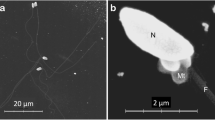Abstract
Viability was determined for oyster spermatozoa maintained in salt water for extended periods after activation and for spermatozoa exposed to thermal and chemical stress. Determinations were based on methods that employ motile gametes and gametes in which eosin-nigrosin stain is repelled as estimates of viability. Motility of spermatozoa maintained in salt water at 25C diminished from 90% to 10% at 173 h after activation. Number of unstained gametes decreased from 95% to 26% at 10 h after activation, and further declined to 6% at 173 h. Spermatozoa exposed to temperatures of −20, 50, and 60 C, and immersed in a phenol-formaldehyde-alcohol solution exhibited motilities of 43, 38, 11, and 7%, respectively, as compared to 90% for unstressed spermatozoa. Percent of unstained gametes after exposure to the above-described stresses was 59, 31, 7, and 0%, respectively, in contrast to 93% for unstressed controls. Correlation between results generated by the motility and staining methods of estimating viability is not significant at the 0.95 probability level.
Similar content being viewed by others
Literature Cited
Blom, E. 1950. A one-minute live-dead sperm stain by means of eosin-nigrosin.Fertility and Sterility 1(2):176–177.
Bunge, R. G., andJ. K. Sherman. 1954. Frozen human semen.Fertility and Sterility 5(2):193–194.
Cochran, W. G. 1953. Sampling techniques. John Wiley & Sons, Inc., N.Y., N.Y. 330 p.
Fribourgh, J. H. 1966. The application of a differential staining method to low-temperature studies on gold-fish spermatozoa.Progr. Fish-Cult. 28:227–231.
Galtsoff, P. S. 1964. The American Oyster. U.S. Dept. Interior, Fish Wildl. Ser. Fish. Cult. 64. 480 p.
Hancock, J. L. 1951. A staining technique for the study of temperature-shock in semen.Nature 167:323–324.
Hodgins, H. O., andG. J. Ridgway. 1964. Recovery of viable salmon spermatozoa after fast-freezing.Progr. Fish-Cult. 26(2):95.
Hoyle, R. J., andD. R. Idler. 1968. Preliminary results in the fertilization of eggs with frozen sperm of Atlantic Salmon (Salmo salar).J. Fish. Res. Bd. Canada 25(6):1295–1297.
Hwang, S., D. Lee, H. Chen, andI. Liao. 1972. Preliminary results in the cryogenic preservation of grey mullet (Mugil cephalus) sperm.J. Fish. Soc. Taiwan 1(2):1–7.
Hwang, S., and H. Chen. 1973. Fertility of male oyster gametes after freeze-thawing. Reprinted from Chinese-American Joint Commission on Rural Reconstruction, Fish. Series No. 15, 5 p.
Inouye, M. 1968. Freezing of mackerel sperm at the Dept. of Fisheries, Tokai Univ. Fish. Econ. Daily, Tokyo, 2 July.
Mann, T. 1964. The biochemistry of semen and at the male reproductive tract. 2nd ed. John Wiley and Sons, Inc., N.Y., N.Y. 493 p.
May, A. W. 1967. Fecundity of Atlantic cod.J. Fish. Res. Bd. Canada 24:1531–1551.
Mounib, M. S., P. C. Hwang, andD. R. Idler. 1968. Cryogenic preservation of Atlantic cod (Gadus morhua) sperm.J. Fish. Res. Bd. Canada 25(12): 2623–2632.
Rothschild, L. 1948. The physiology of sea-urchin spermatozoa. Lack of movement in semen.J. Exp. Biol. 25:344–352.
— 1951. Sea-urchin spermatozoa.Biol. Rev. 26:1–27.
Sherman, J. K. 1955. Temperature shock in human spermatozoa.Proc. Soc. Exptl. Biol. Med. 88:6–7.
Sneed, K. E., andH. D. Clemens. 1956. Survival of fish sperm after freezing and storage at low temperatures.Progr. Fish-Cult. 18:99–103.
Steel, R. G. D., andJ. H. Torrie. 1960. Principles and procedures of statistics. McGraw-Hill Book Co., Inc., N.Y. 481 p.
Terner, C., andG. Korsh. 1963. The oxidative metabolism of pyruvate, acetate, and glucose in isolated fish spermatozoa.J. of Cell Comp. Physiol. 62(3):243–249.
Truscott, B., D. R. Idler, R. J. Hoyle, andH. C. Freeman. 1968. Subzero preservation of Atlantic salmon sperm.J. Fish. Res. Bd. Canada 25(2):363–372.
Van Demark, N. C., K. Koyama, andJ. R. Lodge. 1965. Factors affecting immobilization of bovine spermatozoa with CO2 and their subsequent reactivation.J. Diary Sci. 48:586–591.
Wales, R. G. 1959. The differential staining of human and dog spermatozoa.Australian J. Exptl. Biol. Med. Sci. 37(5):433–439.
Williams, W. W., andO. J. Pollak. 1950. Study of sperm vitality with the aid of eosin-nigrosin stain.Fertility and Sterility 1(2):178–180.
Wood, E. M., andW. A. Dunn. 1948. Fact and fiction in spawn taking.Prog. Fish-Cult 10:67–72.
Author information
Authors and Affiliations
Additional information
Contribution No. 840 of the Center for Environmental and Estuarine Studies.
This study was supported, in part, by a grant entitled “Pilot Shellfish Hatchery in Maryland's Chesapeake Bay” from the Economic Development Administration of the United States Department of Commerce.
Rights and permissions
About this article
Cite this article
Rose, C.D., Heath, E. Viability of American oyster,Crassostrea virginica, spermatozoa exposed to stress. Estuaries 1, 245–251 (1978). https://doi.org/10.2307/1351526
Issue Date:
DOI: https://doi.org/10.2307/1351526




